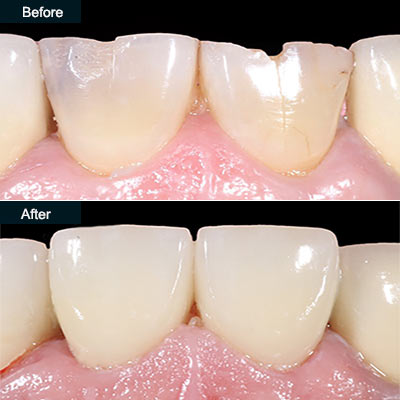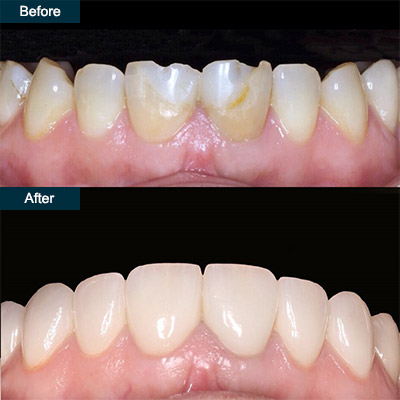Table of contents
Many people have one or two crowns already as these prostheses are used to cover teeth that are badly damaged underneath, protecting and preserving the structure that remains. A well-fitting crown covers the tooth entirely right down to the gum, sealing the tooth underneath so bacteria can’t enter the damaged tooth.

You will need a crown if your tooth has had severe decay or has suffered from some form of trauma resulting in the loss of a substantial portion of its tooth structure.
Dental crowns are also used to restore teeth that have received root canal therapy, where the inner part of the tooth has become severely infected and must be removed to prevent extraction.
When you have a crown fitted, your dentist will need to prepare the tooth, first numbing it with a local anesthetic so you cannot feel anything during this procedure. The dentist will reshape the tooth, getting rid of any decay and infection, and removing enough structure so the crown can fit comfortably over the tooth, ensuring it won’t look too big and bulky.
Once the tooth is prepared, your dentist will need to take a dental impression. While many dentists take a conventional tray impression where you must sit with a mouth tray that takes several minutes to set, an increasing number uses digital dental impressions where your teeth are scanned to create an extremely precise 3-D digital model of your teeth.
When the impression is complete, your new crown can be fabricated. Again, the process here can differ considerably.
Some dentists choose to send the dental impression or digital scan of your teeth to a dental lab where the crown will be made in one or two weeks. In the meantime, your tooth is protected with a temporary crown. Others have on-site equipment that allows them to design and make your crown almost while you wait so it can be fitted on the same day, and there is no need for a temporary crown.
The most modern crowns, especially same-day crowns, are made entirely from ceramic materials and do not contain any metal. These crowns create the absolute best aesthetic outcome because they look amazingly natural.
Veneers are very different from crowns and are not designed to provide support to the tooth. They do not cover the entire tooth and instead are made to fit over the front surface. By covering the front of the tooth, the veneer hides any imperfections underneath.

You can consider a veneer if the tooth in question is generally healthy and strong and does not have any large fillings or other signs of damage. Veneers are wonderful for hiding small cracks and chips in teeth. They can cover severely stained teeth, which cannot be whitened, for example, if they are stained internally.
You can also use veneers to improve the appearance of teeth that are too small, not quite the right shape, or which are worn down.
Veneers can sometimes be an alternative to orthodontics, bringing teeth that are only slightly out of alignment back into line, but it is best to be guided by your dentist if this is the case.
Although orthodontics may take longer to complete, it could be a healthier option for more severely out-of-line teeth. It can correct the way they bite together, potentially improving oral health and providing long-term benefits.
A typical porcelain veneer is around 0.5mm in thickness, so this is the amount of tooth structure your dentist will most likely need to remove from a tooth, ensuring the veneer is not too bulky or unnatural looking. Dentists remove a small amount of your tooth enamel after first numbing your tooth.
Next, your dentist takes a detailed dental impression, either a tray impression or a digital scan. They will then send the information to their dental lab, or some may choose to make the veneer on-site, in a similar way to fabricating a same-day crown. If your dentist sends your impression to a dental lab for fabrication, they will fit temporary veneers to protect your teeth until your new veneers are ready to fit.
Some veneers do not require any tooth preparation and are therefore called prepless or prep-free veneers. They are made from a special type of porcelain that is particularly thin and durable, so the veneer is only about 0.2mm in thickness.
Although more expensive than conventional porcelain veneers, these veneers last longer and can look exceptionally beautiful.
Another type of veneer may also require no tooth preparation and can usually be completed during a single dental appointment. Composite resin veneers are made from the same material used to fill teeth invisibly. The composite resin is applied directly to the tooth’s front surface and bonds firmly to the tooth.
You may also hear this treatment referred to as dental bonding. Once the composite resin is in place, your dentist will shape and polish it, and the final results can look pretty good. Dental bonding is better when you have one or two teeth that need covering, and this material is not as stain-resistant or as strong as porcelain, so you will need to replace these restorations in a few years. However, the treatment is very budget-friendly.
Your dentist will be able to explain these treatments in more detail and can help to guide your decision. Generally, it is better to choose the least invasive treatment possible and preserve the maximum amount of your healthy tooth structure.
You should always avoid having dental crowns fitted over healthy and strong teeth, as once removed, this structure can only ever be replaced artificially.
For more information about crowns or veneers call or visit our dentistry center in Brooklyn, NY.